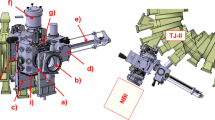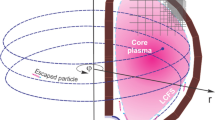Abstract
While high-Z solid plasma-facing components (PFCs) are the leading candidates for reactors, it is unclear that they can survive the intense plasma material interaction (PMI). Liquid metals (LM) PFCs offer potential solutions since they are not susceptible to the same type of damage, and can be “self-healing”. Following the Fusion Energy System Study on Liquid Metal Plasma Facing Components study that recently was completed by Kessel et al. (Fusion Sci Technnol 75:886, 2019) a domestic LM PFC design program has been initiated to develop reactor-relevant LM PFC concepts. This program seeks to evaluate LM PFC concepts for a Fusion Nuclear Science Facility (FNSF) or a Compact Pilot Plant via engineering design calculations, modeling of PMI and PFC components and laboratory experiments. The latter involves experiments in dedicated test stands and confinement devices and seeks to identify and answer open questions in LM PFC design. The new national LM PFC program is first investigating lithium as the plasma facing material for a flowing divertor PFC concept. Several flow speeds will be evaluated, ranging from ~ cm/s to m/s. The surface temperature will initially be held below the strongly evaporative limit in the first design; higher temperatures with strong evaporation will be considered in future concepts. Other topics of interest include: understanding of the hydrogen and helium interaction with the liquid lithium; single effect experiments on wetting, compatibility and embrittlement; and prototypical experiments for control and characterization of flowing LM. A path to plasma and future tokamak exposure of these concepts will be developed.





Similar content being viewed by others
References
C.E. Kessel et al., Fusion Sci. Technnol. 75, 886 (2019)
G.F. Matthews et al., Phys. Scr. T138, 014001 (2009)
G. Federici et al., Nucl. Fusion 41, 1967 (2001)
A. Loarte et al., Nucl. Fusion 54, 033007 (2014)
H. Zohm et al., Nucl. Fusion 53, 073019 (2013)
G. Federici et al., J. Nucl. Mater. 313–316, 11 (2003)
M.J. Baldwin, R.P. Doerner, Nucl. Fusion 48, 035001 (2008)
M.J. Baldwin et al., J. Nucl. Mater. 390–391, 886 (2009)
M. Kotschenreuther et al., Phys. Plasmas 14, 072502 (2007)
T. Eich et al., Nucl. Fusion 53, 093031 (2013)
R.J. Goldston, Nucl. Fusion 52, 013009 (2012)
A.S. Kukushkin et al., J. Nucl. Mater. 438, S203 (2013)
A.S. Kukushkin et al., Nucl. Fusion 53, 123024 (2013)
R. Maingi, Nucl. Fusion 54, 114016 (2014)
T.K. Gray et al., J. Nucl. Mater. 415, S360 (2011)
B. LaBombard et al., Phys. Plasmas 18, 056104 (2011)
M.A. Makowski et al., Phys. Plasmas 19, 056122 (2012)
M. Ono et al., Nucl. Fusion 52, 023012 (2012)
F.L. Tabarés, Plasma Phys. Control. Fusion 58, 014014 (2016)
R. Majeski, AIPS Conf. Proc. 1237, 122 (2010)
I.E. Lyublinski, A.V. Vertkov, V.A. Evtikhin, Plasma Dev. Oper. 17, 265 (2009)
P.C. Stangeby, J. Nucl. Mater. 415, S278 (2011)
R. Majeski et al., Phys. Rev. Lett. 97, 075002 (2006)
M.G. Bell et al., Plasma Phys. Control. Fusion 51, 124054 (2009)
R. Maingi et al., 2015 Proceedings of the 26th SOFE conference, Austin TX, 31 May–4 June, 2015. ISBN:978-1-4799-8264-6, p. 899
J.C. Schmitt et al., Phys. Plasmas 22, 056112 (2015)
D.P. Boyle et al., Phys Rev Lett 119, 015001 (2017)
R. Maingi et al., Nucl. Fusion 52, 083001 (2012)
J.S. Hu et al., Phys. Rev. Lett. 114, 055001 (2015)
T.H. Osborne et al., Nucl. Fusion 55, 063018 (2015)
G.Z. Zuo et al., Nucl. Fusion 57, 046017 (2017)
R. Maingi et al., Nucl. Fusion 58, 024003 (2018)
G.Z. Zuo et al., Nucl. Fusion 59, 016009 (2019)
J.S. Hu et al., Nucl. Mater. Energy 18, 99 (2019)
S. Smolentsev et al., 2019 Fusion Science Techn.at press
S. Smolentsev, M. Abdou, Appl. Math. Model. 29, 215 (2005)
S. Smolentsev et al., Fusion Eng. Des. 100, 65 (2015)
J. Drobny, D. Curreli, Comp. Mater. Sci. 149, 301 (2018)
R. Khaziev, D. Curreli, Phys. Plasmas 22, 043503 (2015)
R. Khaziev, D. Curreli, Comp Phys Comm 229, 87 (2018)
D. Bernholdt et al., 2019 Final Report for the FY2018 Fusion Theory and Simulation Milestone on Plasma Materials Interaction, Department of Energy Theory Milestone Report
S. Keniley, D. Curreli, Fusion Sci. Techn. 71, 93 (2017)
P. Fiflis et al., Fusion Eng. Des. 89, 2827 (2014)
O.K. Chopra et al., Fusion Technol. 8, 1956 (1985)
T. Flament et al., J. Nucl. Mater. 191–194, 132 (1992)
B. Joseph et al., Eur. Phys. J. Appl. Phys. 5, 19 (1999)
M.G. Hvasta et al., Nucl. Fusion 58, 016022 (2018)
M. Modestov et al., Nucl. Fusion 58, 016009 (2018)
K. Kusumi et al., Fusion Eng. Des. 136, 223 (2018)
M.G. Hvasta et al., Rev. Sci. Instrum. 88, 013501 (2017)
A.Y. Ying et al., Fusion Eng. Des. 72, 35 (2004)
Acknowledgements
This work is supported in part by the U.S. Department of Energy under contracts DE-SC0020642, DE-AC02-09CH11466, DE-AC05-00OR22725, and UCLA appreciate support from the sub-contract with ORNL 4000171188.
Author information
Authors and Affiliations
Corresponding author
Additional information
Publisher's Note
Springer Nature remains neutral with regard to jurisdictional claims in published maps and institutional affiliations.
Rights and permissions
About this article
Cite this article
Andruczyk, D., Maingi, R., Kessel, C. et al. A Domestic Program for Liquid Metal PFC Research in Fusion. J Fusion Energ 39, 441–447 (2020). https://doi.org/10.1007/s10894-020-00259-0
Accepted:
Published:
Issue Date:
DOI: https://doi.org/10.1007/s10894-020-00259-0




